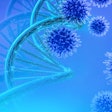
U.K. regulators have approved the “first ever” trial of a revolutionary gene therapy for young children diagnosed with Hunter syndrome, a rare lysosomal storage disorder.
Five children under the age of 1 with the condition, also known as mucopolysaccharidosis type II (MPSII), will be treated with autologous hematopoietic stem cell (HSC) gene therapy. The trial -- a 24-month, single-arm, open-label study -- will evaluate the HSC gene therapy’s safety and tolerability, as well as its pharmacodynamic and clinical efficacy. It will be conducted at Royal Manchester Children’s Hospital in collaboration with the Manchester Centre for Genomic Medicine at Saint Mary’s Hospital, both of which are part of Manchester University National Health Service Foundation Trust.
Mucopolysaccharides are long chains of sugar molecules used in the building of bones, cartilage, skin, tendons, and many other tissues in the body. Children with Hunter syndrome are missing a gene that produces an enzyme called iduronate-2-sulfatase (IDS), which is necessary to properly break down these complex sugar molecules; these mucopolysaccharides build up and are stored in the cells in the body, causing progressive damage. Symptoms include learning and memory problems, heart and lung dysfunction, hyperactivity and behavioral problems, bone and joint malformations, and hearing impairment.
Preclinical studies conducted in mice showed the potential to correct disease in the body and normalize brain pathology. They were carried out by Brian Bigger, professor of cell and gene therapy at the University of Manchester, and colleagues, with results published recently in Molecular Therapy Methods and Clinical Development.
In gene therapy, HSCs are collected from the patient and a working copy of the gene is inserted into the HSCs using a lentiviral gene therapy vector. The modified HSCs are then infused back into the patient to engraft in the bone marrow to produce “daughter blood cells” that contain the IDS gene and enzyme, which are distributed throughout the body, including the brain.
“The newly inserted IDS gene produces an IDS enzyme that contains a proprietary ApoEII-tagged sequence, which can bind to ApoE-dependent receptors on the blood brain barrier, and move enzyme into the brain more efficiently, thus potentially normalizing brain pathology,” Bigger said.
“This should speed up delivery of enzyme to the brain, where it is most needed as we can leverage all the enzyme produced by the blood to do this rather than just relying on the engraftment of monocyte cells from the blood into the brain,” he added.
The new trial will include children who may already be on enzyme replacement therapy but have not yet declined developmentally. They will continue to receive enzyme replacement therapy during treatment; however, the trial’s aims include removing the need for weekly enzyme replacement therapy over a child’s lifetime and being able to safely target the brain disease experienced by these patients.
Bob Stevens, chief executive of the U.K. charity MPS (Mucopolysaccharide) Society, said that the study could lead to new treatment options in the future for patients with the severest form of MPSII Hunter syndrome.



















